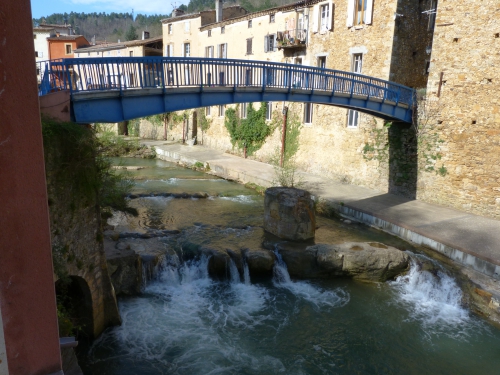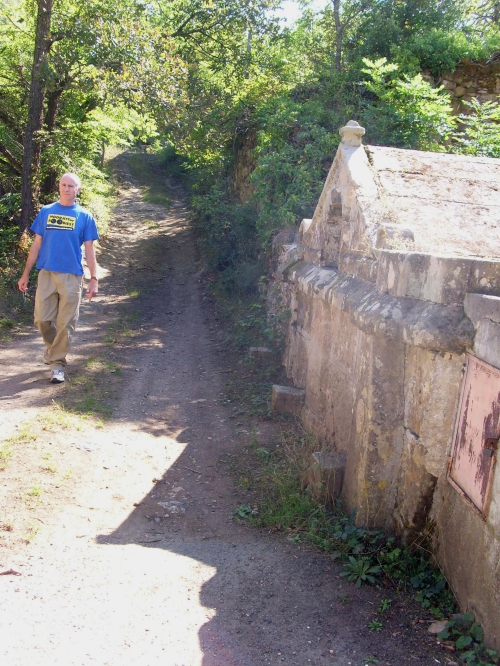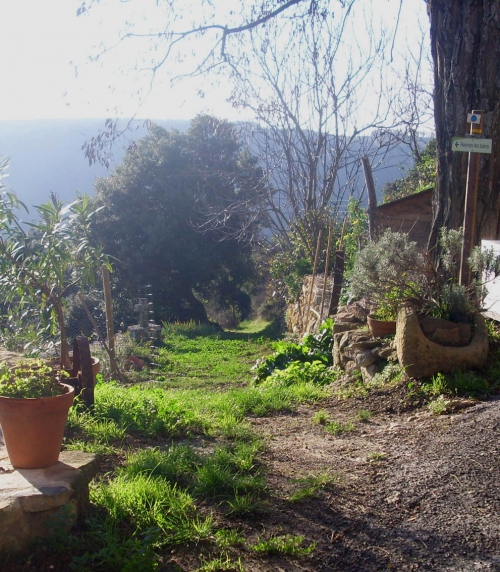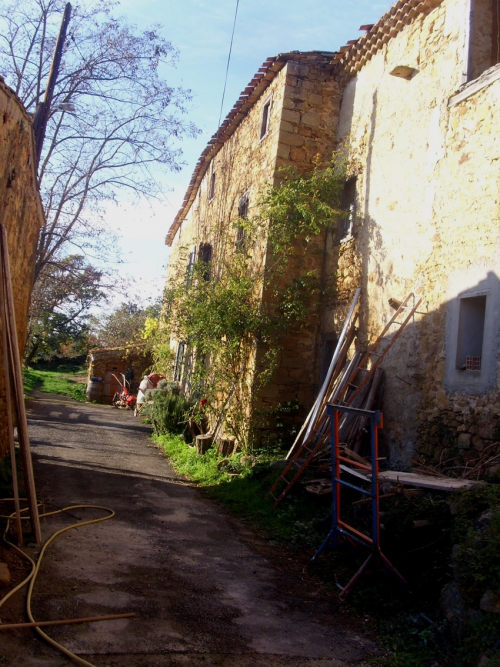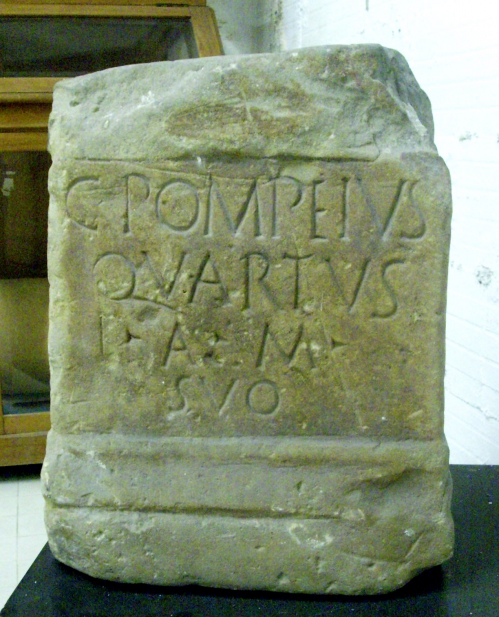Rennes-les-Bains town
Rennes-les-Bains

It's lovely and peaceful down by the water in the centre of Rennes-les-Bains
The town Montferrand the museum
Rennes-les-Bains is some 15 km to the east of Rennes-le-Chateau - one has to descend into Couiza village, then turn right to cross over the river, then turn right again for Rennes-les-Bains.
Interest in the village began with the explosion of the Rennes-le-Chateau mysteries, because the priest of "les Bains," Henri Boudet, was a great friend of Bérenger Sauniere, and made many financial contributions towards the restoration of the church. Now the number of people researching and enjoying Rennes-les-Bains is increasingly steadily and the village is becoming fashionable. It is especially associated with Pierre Plantard and Mary Magdalene.
The town was founded by the Romans about 45BC, they came looking for mineral wealth - salt, tin, iron - and discovered the thermal springs. The first they exploited was the one underneath the Hostellerie, the large pink hotel by the river, and the second, with an incredibly luxurious suite that the Emperor Augustus used to visit, where is now the Bains de Reine, with their new swimming pool built over the Roman remains.
The "Place de Deux Rennes" was originally the Roman market place, while across the road was the Roman Forum.
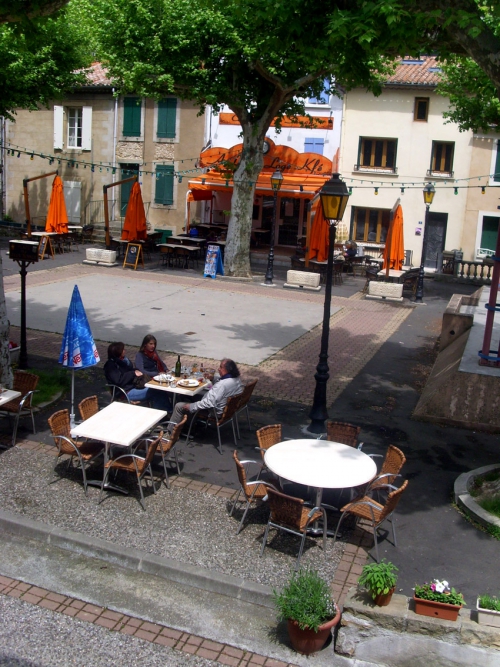
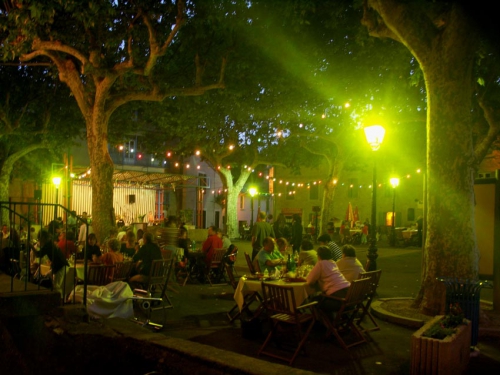
By day and night - second photo courtesy Jaap Rameijer
Contrary to popular belief, the name "Deux Rennes" for the place does not refer to the castles and the baths - Rennes-le-Château and Rennes-les-Bains - but to Rennes-les-Bains and Rennes in Brittany, with which Rennes-les-Bains is twinned.

Even so, this second picture was called the two maires of the two Rennes! Les deux maires des deux Rennes!
Local beauty spots.
Image courtesy Anneke Foremans, Barinca Travel
The Garden of Paul Courrent is near the bridge in our first picture and is a delightful riverside spot. He was a friend of Bérenger Saunière, a doctor and wine-maker, who wrote a book about the history of Rennes-les-Bains and especially its baths.
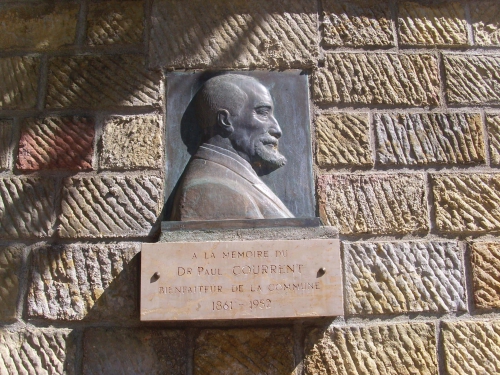
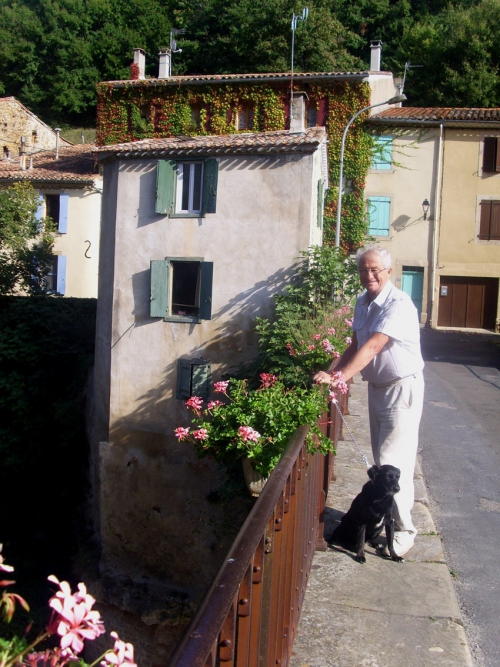
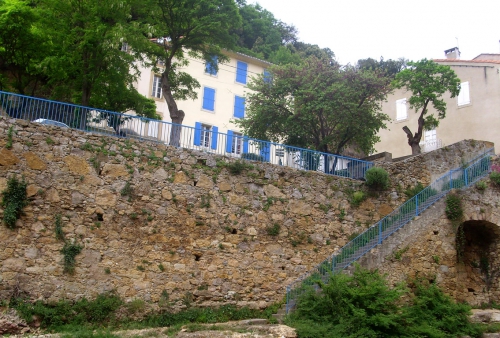
Cross the old "Roman bridge" to look back on the Jardin de Paul Courrent and the river Sals. The bridge is not Roman; the original Roman bridge, all except a small part of it, was situated where is today's blue painted passerelle. You can see the remains of the Roman stanchion beneath it.
Montferrand up the hill
On Sunday 6th September 2009 I went with my friend Patrick to Rennes-les-Bains and I very much wanted to see Montferrand. I had an idea the Romans lived there before they lived in the valley below with the famous baths.
We saw clear blue skies and the temperature rapidly rising to 27 degrees. The views were tremendous, you could see for miles, and the hamlet faced south; the Romans liked to build on south-facing slopes. There was also a natural source of fresh water, which the Romans would have liked, indeed, had needed, for the River Sals in the valley was salty.
The main attraction of Montferrand seemed to the path by the water source, up to Mont Cardou, which many people think contains, somewhere, the grave of Jesus.
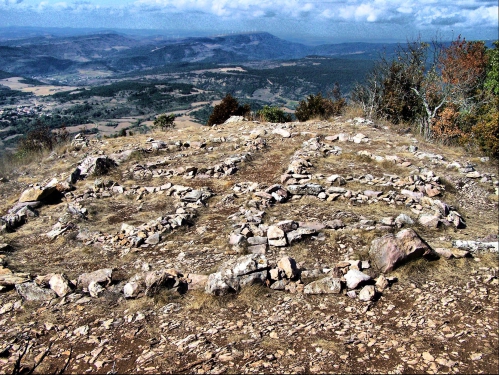
On top of Cardou are stones laid out in the shape of an Occitan cross. At one time these stones were in the shape of an arrow, intended to guide UFO's! They had been placed there by teepee-dwellers that the local people considered more than a little weird, so when those people left Rennes-les-Bains, the local people made the stones into an Occitan cross.
In 2011 I began researching for my book about Rennes-les-Bains. (Here.) There was a ruined chateau at Montferrand, marked on the map. But who had lived there? Then I found some Births, Marriages and Deaths documents of the seventeenth and eighteenth centuries; to my surprise Montferrand was bigger than it is now, as was Sougraigne, and the people used to walk or ride between the two, especially the shepherds. Montferrand was certainly inhabited enough to support the building of a lavoir, or washing place, for the use of the village women.
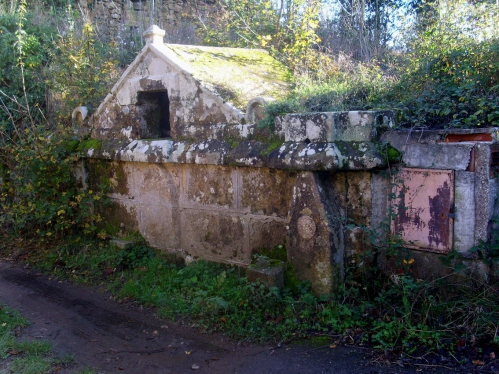
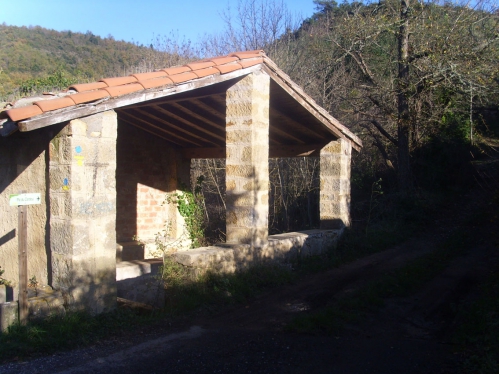
The old water source and the lavoir.
The hamlet was probably built around this natural spring, in Celtic and then Roman times, when you remember that the water in the valley was thermal or salty. From the source, turn left, and the road follows the contours of the hillside until you come to the ruins of the château at the far end. Along the way you'll see a plnth on the left; but what has happened to the cross?
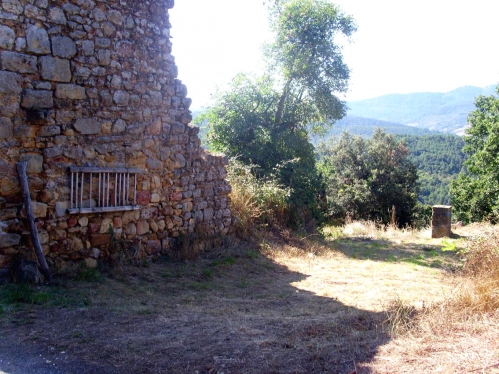
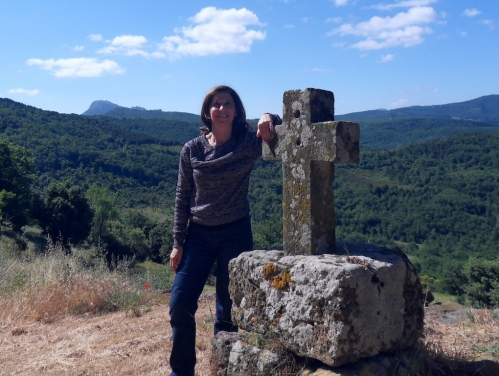
Here's Kris Darquis beside it. Then a bit further along is the remains of the Roman road going down to the baths in the valley. The second photo is the last house of the village; after that is the ruins of the château.
There is even a path marked there, where was the Roman road down into the valley.
This importance of Montferrand was confirmed by a look at place names; right up to the Revolution (1789) the place was known as Montferrand-les-Bains. Unlike today, when Montferrand is a satellite of Rennes-les-Bains, in pre-Revolutionary days, Rennes-les-Bains was a satellite of Montferrand!

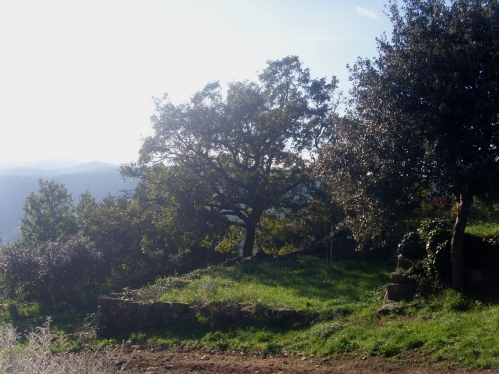
All that remains of the chateau
There is evidence the chateau was in use by the aristocratic Fleury family towards the end of the 1790's; some of the family left during the Revolution, and as happened in many places at the time, the chateau was abandoned or else stripped of possessions by the country people. Now the ruins are walls only a metre high, and most of the hamlet of Montferrand is owned by a lawyer from Paris. It is becoming more popular now and many houses are being renovated.
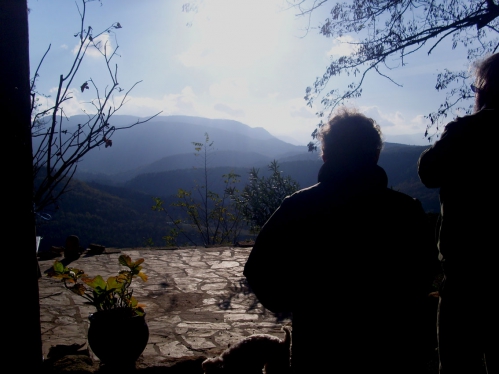
Looking south from Montferrand
It is my belief the chateau started life as a Roman watch-tower, when you think a watch-tower was necessary to watch over the valley and especially the gold-mine on the hill opposite, at Roc Négré. No trace of this legendary mine has ever been found; but across the northern valley from Montferrand, just north the chateau, is a ruined mine. It's marked on the IGN map. A local man told me this was the legendary gold-mine.
But I didn't believe him, or rather, I suppose the gold-mine was certainly legendary! The name of the hamlet, Montferrand tells us clearly that Montferrand was, or guarded, an iron mine. The name means "Mountain of Iron." The chateau, on the very highest part of Montferrand, was the site of a Roman watch-tower to guard this iron mine. This watch-tower would have been renovated by the Visigoths in the 6th century, who were very concerned to protect themselves from invasions from the north; from the Franks, the ever resented "men from the north" who later took Languedoc from the Cathars.
I confirmed this research during a visit in early November 2011, and my friends too, agreed with my findings. And we all found Montferrand quite magic and wonderful.
There is much more about it in my Rennes-les-Bains book with its "Secrets of Montferrand" chapter. Another chapter in the book will tell you where you can really find gold.
Talking about the Romans . . . Those interested in the history of the town can see some remains from its illustrious past is the small museum, a part of the Salle de Patrimoine, opposite Hôtel de France. There is much documentary evidence describing valuable finds, especially gold and silver coins, but these have all disappeared, presumably sold to dealers when times were hard. But the museum does include several major finds and much evidence of the Roman life here, 43BC to 420AD.
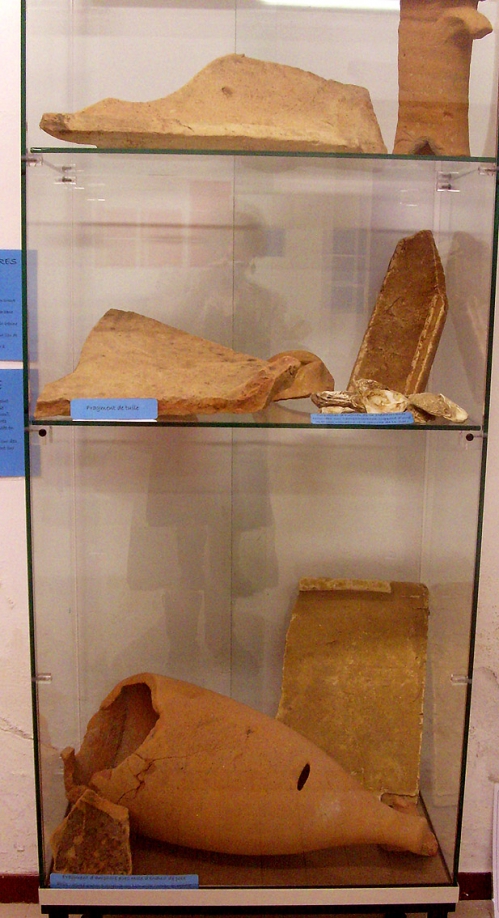
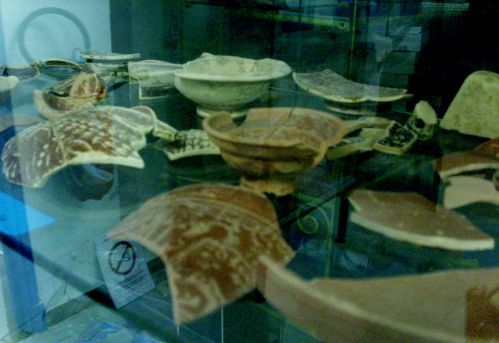
Amphores, rooftiles and sigillée pottery are found everywhere that the Romans lived in our region. They came to Rennes-les-Bains on an exploratory expedition, around 50BC. They were investigating the Corbières for wealth to exploit, especially metal mines, which they found in abundance. (There is a legendary gold mine at Rennes-les-Bains, but so far no-one has found it.) They established iron and lead mines, and mined deposits of jet and amber. They found the salty source of the River Sals - so valuable to them because the only preservative for food at the time was salt. It was much easier to evaporate the salt from the river water than to mine it, as the Celts and the Romans did in northern France.
Soon the warm waters were found and three sources were combined to make a magnificent suite of cool, tepid and warm Roman baths, where is now the Bains de la Reine. The establishment was very like the sports centres of today, for it included a sauna and a restaurant. In the floods of 1992 part of the modern structure was swept away and the fantastic high-quality mosiacs were revealed; to be covered over by today's new bath on stilts after the archeologists had done their research.
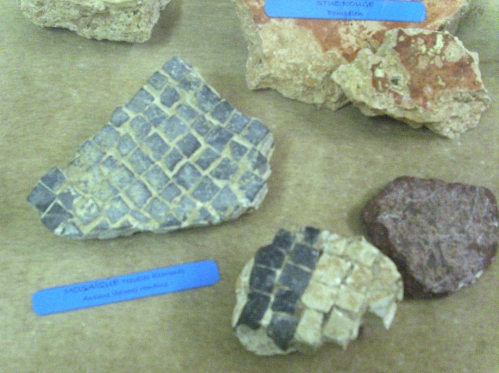
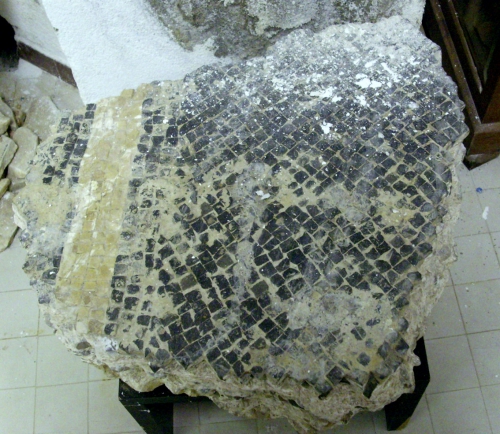
In the museum is a Roman altar stone. These small altars were made everywhere, often in people's houses, basically plinths to support a statuette or a bowl to collect the blood of sacrifices. Some had just a flat surface where offerings could be left, flowers or fruit, or a candle or lamp lit. The message is put in place by the person who erected the altar.
Another item of interest is the head discovered by Henri Boudet, the priest who wrote a book in 1886, which makes it obvious he thought the head was of Our Saviour, Jesus, and hence Jesus had lived at Rennes-les-Bains. The priest had hacked this head from a menhir near the land now called L'Homme Mort, and it was cemented into the wall of the presbytère for many years. But it was not the head of Jesus, the archeologists say it was the head of a Celtic Goddess and have called her The Goddess of the Waters.
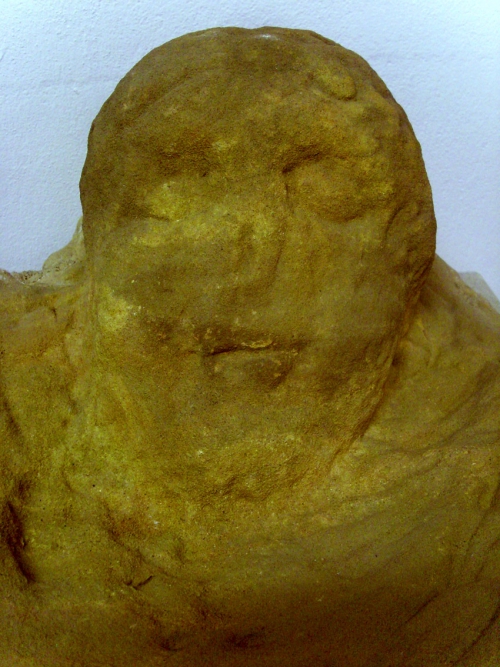
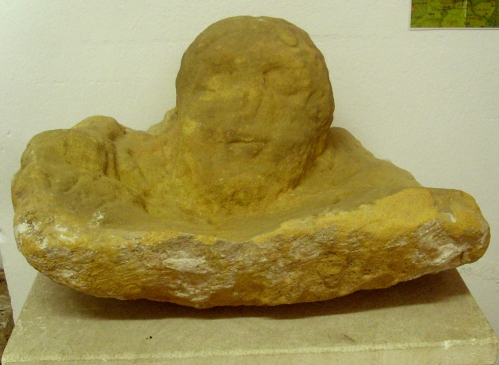
After the Romans came the Visigoths; they left a decorated gourd with an apparent crucifix on it, but I am dubious, I think it was just a equal-armed cross as their Cross of Silence, which appears on the Visigothic altar pillar which was found at Rennes-le-Château. 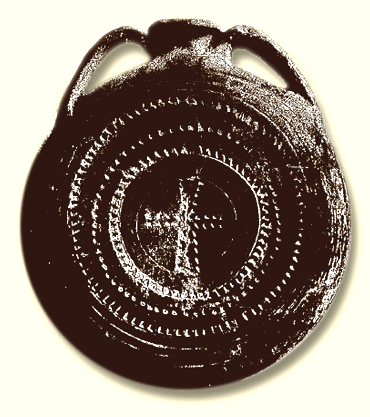
They also left a vase, which was used for a long time to decorate the Source du Cercle, but it is now on show in the museum.
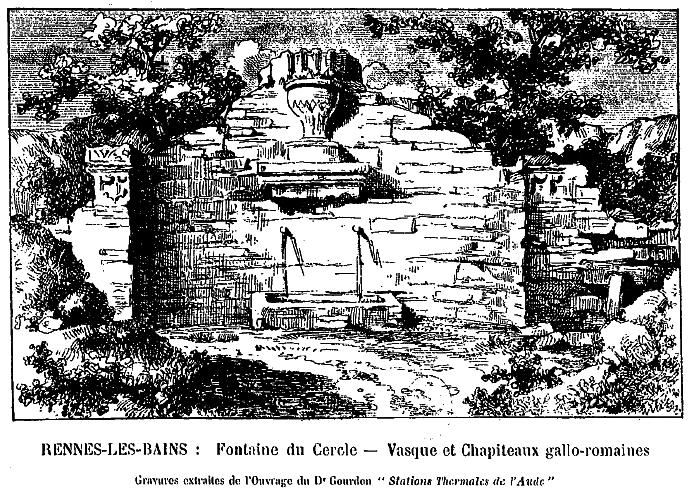
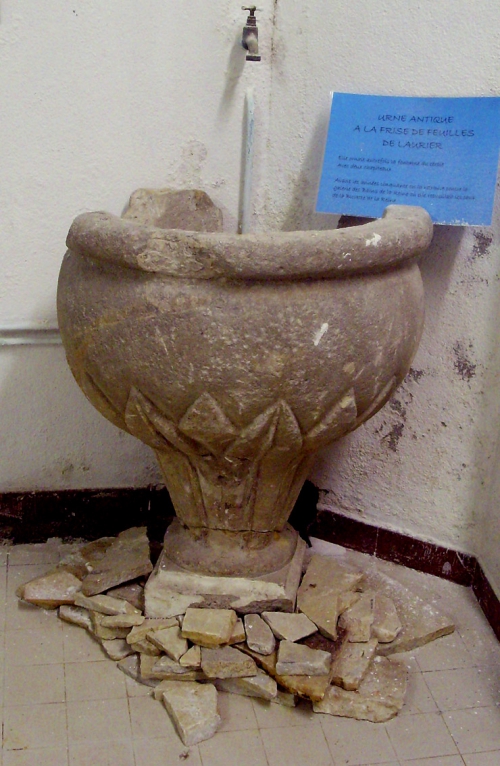
There is much more about the history of Rennes-les-Bains in my book, "The Sacred River of Rennes-les-Bains." For further details, click here
Inscrivez-vous au blog
Soyez prévenu par email des prochaines mises à jour
Rejoignez les 97 autres membres


